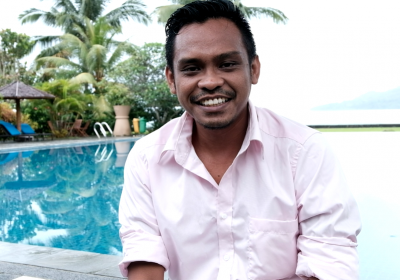Morika Tetelepta: Enrapturing Art and Culture in the Land of Maluku
June 26, 2018
Morika Tetelepta, one of the 15 Archipelago Emerging Writers
Ambon, Maluku, the city is known to have produced many melodious voice singers. Not only musicians were born here. New figures in the literature sector also arise. A lot of young poets prove themselves through remarkable works, such as Chalvin Jems Palilaya, Eko Saputra Poceratu, and also Morika Tetelepta
Morika is the only participant from Ambon who is present at international literature event namely Ubud Writers and Readers Festival 2017. Morika, who is also a musician and rapper, brings forward about five poems. His name is also chosen as one of the 15 Archipelago Emerging Writers by a curator team consisting of top litterateurs or writers; Seno Gumira Ajidarma, Leila S. Chudori and Warih Wisatsana. Morika follows the steps of the local writer, Chalvin Palilaya, which was present in the event of 2016. Unfortunately, the art and literature community in Maluku only flourishes in the capital of the province, Ambon.
Morika said building an art and literature in Maluku wasn’t as easy as turning the palm of the hand. Information is still centred on big cities, such as Ambon. As a result, remote areas in Maluku are left behind and aren’t able to develop their art potentials.
“People in the areas are very literary. They still study the 1945 literature batch, like Chairil Anwar. That means the teachers require latest literature information and that can only happen if information flow from the center, like Ambon, is delivered to isolated places,” said Morika when encountered during the sidelines of the Road to Indonesia Development Forum in Ambon, end of May 2018.
IDF 2018 is a forum held by the National Development Planning Agency or Bappenas and is supported by the Government of Australia through Knowledge Sector Initiative (KSI). IDF 2018 drives accelerated development in Indonesia to be more equal and sustainable based on knowledge, experience and fact.
This year, IDF takes a theme of “Pathways to Tackle Regional Disparities across the Archipelago”. The result of this year’s forum will be used as materials to compose National Medium Term Development Plan 2020-2024.
Spreading the Local Literacy Potential
Morika said other factors causing art community in Maluku unable to develop fully was because many of the local’s residents were not confident competing with writers from other provinces even though art and culture in Maluku had its own characteristic compared to that of other areas. The province’s numerous islands and sea can become its own identity.
The next problem is the low reading interest level of the Maluku kids. Morika once observes the number of book shipping to Maluku which is far below that of other provinces. A number of bookstores are less visited by guests.
“Within a year, only 6,000 books coming in and that are very far from other regions. Not only that, very few of book publishing, printing that is handled by local writers. Literacy tradition runs so dimly,” Morika said.
That is why Morika and his friends are committed to spreading literature works of Maluku hence they can be widely-read. He is actively looking for publishers and translators for writers from Ambon so that their works can be read outside the province. His experience at Ubud Writer becomes a stepping point for his effort setting up a literature community in Maluku.
Art and Economy Can Walk Hand in Hand
His experience at the Ubud Writers provides a lesson on how art and culture can walk hand in hand with economic growth. In Ubud, Bali, tradition can be preserved as a tourist attraction to stimulate economic growth.
“Why has the tradition in my place been shifted, destroyed? There are many local languages in Maluku that are already extinct. I feel we can make that (the kind of culture and tourism in Ubud) in Maluku if we are serious keeping what we already have,” Morika said.
According to him, every region has potential and art that can be explored. After knowing the potential, Morika and his fellows formulate art and tradition strategies that can be carried out together with the society to later provide them with economic values. For instance, every village has an oral literature that can be put as commercial stage show if well-packaged.
Although Maluku doesn’t have any Art Councils, according to Morika, the Culture Park of Maluku frequently displays artworks from existing communities in the province. In addition, Morika plans printing postcards containing literature work citations with Maluku scenery as the backgrounds.
Of course, Morika and his community pals cannot walk alone. He needs supports from various parties, such as local administration, academicians or media so as art in Maluku can grow well and widely-recognized.
“The local administration often invites us to play and appreciate works. We need to meet more often so we won’t be awkward anymore because the administration and the community have different working style,” Morika said.**
Indonesia’s Research Institutions Supporting the Development of the Electric Vehicle Industry
Indonesian Muslim Fashion and Cosmetics IKMs Shine at Dubai World Expo 2020
Govt Steps Up UMKM Transformation Efforts in the Midst of Pandemic Slowdown
Govt Encourages Promotion of IKM Products in Digital Era
Government Begins Developing Maritime Training Center in Makassar
Tweets by IDDevForum
